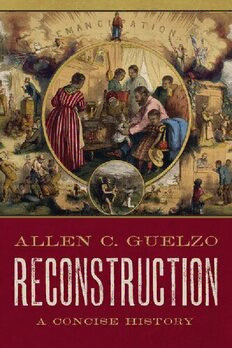
Reconstruction: A Concise History PDF
Preview Reconstruction: A Concise History
i RECONSTRUCTION ii iii Reconstruction A Concise History Allen C. Guelzo 1 iv 1 Oxford University Press is a department of the University of Oxford. It furthers the University’s objective of excellence in research, scholarship, and education by publishing worldwide. Oxford is a registered trade mark of Oxford University Press in the UK and certain other countries. Published in the United States of America by Oxford University Press 198 Madison Avenue, New York, NY 10016, United States of America. © Oxford University Press 2018 All rights reserved. No part of this publication may be reproduced, stored in a retrieval system, or transmitted, in any form or by any means, without the prior permission in writing of Oxford University Press, or as expressly permitted by law, by license, or under terms agreed with the appropriate reproduction rights organization. Inquiries concerning reproduction outside the scope of the above should be sent to the Rights Department, Oxford University Press, at the address above. You must not circulate this work in any other form and you must impose this same condition on any acquirer. Library of Congress Cataloging- in- Publication Data Names: Guelzo, Allen C., author. Title: Reconstruction : a concise history / Allen C. Guelzo. Description: New York, NY : Oxford University Press, [2018] | Includes bibliographical references and index. Identifiers: LCCN 2017036014 (print) | LCCN 2017036811 (ebook) | ISBN 9780190865702 (updf) | ISBN 9780190865719 (epub) | ISBN 9780190865696 (hardback : alk. paper) Subjects: LCSH: Reconstruction (U.S. history, 1865–1877) | United States—Politics and government—1865–1877. Classification: LCC E668 (ebook) | LCC E668 .G89 2018 (print) | DDC 973.8—dc23 LC record available at https://lccn.loc.gov/2017036014 1 3 5 7 9 8 6 4 2 Printed by Edwards Brothers Malloy, United States of America v CONTENTS Acknowledgments | vii Introduction | 1 Chapter One: Vengeance: April– December 1865 | 15 Chapter Two: Alienation: December 1865– March 1867 | 29 Chapter Three: Arrogance: March 1867– May 1868 | 41 Chapter Four: Resistance: May 1868– March 1869 | 55 Chapter Five: Distraction: March 1869– May 1872 | 69 Chapter Six: Law: 1866– 1876 | 84 Chapter Seven: Dissension: September 1872– April 1877 | 97 Epilogue | 115 TIMELINE | 131 NOTES | 137 BIBLIOGRAPHY | 163 INDEX | 173 v vi vii ACKNOWLEDGMENTS Several talented and thoughtful historians and commentators took away time from their own schedules and their own more important tasks to read and review the manuscript of Reconstruction; I regret to admit that I have no better means of recognizing their generosity and perspicacity than these simple acknowledgements. James Oakes (City University of New York) was the first on whom I tried out the idea of Reconstruction as a bourgeois revolution, and his unfeigned interest fed the spark until it glowed. Louis Masur (Rutgers University) combed through each chapter, relentlessly sniffing out every gaffe and indiscretion, as did Jonathan White (Christopher Newport University). Michael Lind (New America Foundation), Steven Woodworth (Texas Christian University), Matthew Norman (University of Cincinnati), and Brian M. Jordan (Sam Houston State University) also volunteered themselves to read parts here and there. Any errors that might unfortunately appear in the interpreta- tions and writing here must be blamed on me; however, any praise must be shared equally with all of those named above. vii viii 1 Introduction The era in US history known as Reconstruction forms a sort of coda to the traumatic years of the American Civil War, which lasted from 1861 to 1865. It embraces the twelve years of active effort to rebuild and reconstitute the American Union after the attempt by the Confederate States of America to secede from it, and in some sense (because it had no official starting or ending date) it spluttered on well into the 1890s. But Reconstruction can also reasonably be characterized as the ugly duckling of American history. The twelve years that are the conventional designation of the Reconstruction period, from 1865 to 1877, teem with associations and developments that seem regrettable, if not simply baleful. They left a long legacy of bitter- ness, especially among Southerners who believed that they had fought an honorable war and were handed a dishonorable peace, as well as Southerners who refused to accept defeat and manufac- tured the myth of a glorious “Lost Cause” to justify themselves and their continuing belief in the rightness of the Confederate project. Reconstruction also coincided with an eruption of notorious levels of graft, corruption, and fraud in American civil governments— not least in the ones erected by federal force in the former rebel states. But Reconstruction is probably best known, and least liked, as the greatest missed opportunity Americans ever had to erase the treach- erous impact of slavery and race in a reconstructed and unified nation. There is, in other words, something in Reconstruction for nearly every American to regret.1 1
